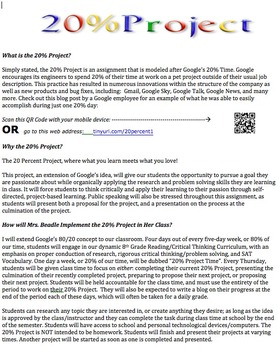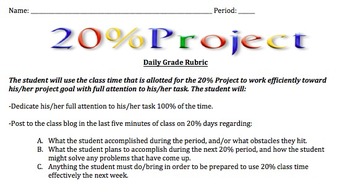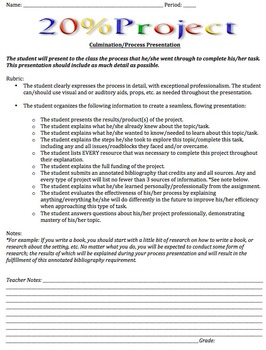20% Project Explanation AND Rubrics Project Based Learning
Going the Distance
38 Followers
Grade Levels
7th - 12th, Higher Education, Homeschool
Formats Included
- Word Document File
Pages
6 Pages
Going the Distance
38 Followers
Description
Here is the explanation I am handing out to parents and students. of course, every document in this file will need to be edited to adhere to your classroom, school and district policies. Also, feel free to check out my free preview file which includes this explanation plus the first of the four rubrics for the assignment.
What is the 20% Project?
Simply stated, the 20% Project is an assignment that is modeled after Google’s 20% Time. Google encourages its engineers to spend 20% of their time at work on a pet project outside of their usual job description. This practice has resulted in numerous innovations within the structure of the company as well as new products and bug fixes, including: Gmail, Google Sky, Google Talk, Google News, and many more. Check out this blog post by a Google employee for an example of what he was able to easily accomplish during just one 20% day: tinyurl.com/20percent1
Why the 20% Project?
The 20 Percent Project, where what you learn meets what you love!
This project, an extension of Google’s idea, will give our students the opportunity to pursue a goal they are passionate about while organically applying the research and problem solving skills they are learning in class. It will force students to think critically and apply their learning to their passion through self-directed, project-based learning. Public speaking will also be stressed throughout this assignment, as students will present both a proposal for the project, and a presentation on the process at the culmination of the project.
How will Mrs. Beadle Implement the 20% Project in Her Class?
I will extend Google’s 80/20 concept to our classroom. Four days out of every five-day week, or 80% of our time, students will engage in our dynamic 8th Grade Reading/Critical Thinking Curriculum, with an emphasis on proper conduction of research, rigorous critical thinking/problem solving, and SAT Vocabulary. One day a week, or 20% of our time, will be dubbed “20% Project Time”. Every Thursday, students will be given class time to focus on either: completing their current 20% Project, presenting the culmination of their recently completed project, preparing to propose their next project, or proposing their next project. Students will be held accountable for the class time, and must use the entirety of the period to work on their 20% Project. They will also be expected to write a blog on their progress at the end of the period each of these days, which will often be taken for a daily grade.
Students can research any topic they are interested in, or create anything they desire; as long as the idea is approved by the class/instructor and they can complete the task during class time at school by the end of the semester. Students will have access to school and personal technological devices/computers. The 20% Project is NOT intended to be homework. Students will finish and present their projects at varying times. Another project will be started as soon as one is completed and presented.
Failure is acceptable.
If students know that “failure” is acceptable, they should feel free to take risks to pursue their passions.
If a student’s proposal is approved but the project fails, the student will be expected to give their process presentation, which will describe the steps they took toward completing the project, including the unresolvable problem that halted realization of the goal, and what the student learned from the project. The student will then begin a new project with a new proposal to the class/instructor.
Students will be expected to work out any issues they can foresee in their plan prior to proposing an idea. They will also be strongly encouraged to find a solution to any unforeseen problem that pops up. That being said, all attempts at goal completion will be counted as a learning experience, and absolutely no credit will be lost if a student hits an unforeseen roadblock. The student’s grade will always be determined based on their use of the class time, and their ability to communicate the process they went through in pursuit of completion of the goal. No student’s grade will be based on success or failure.
“It is better to try and fail than to fail to try.” -Spencer Kagan.
I personally believe that people learn more often from failure than from success. How many times does a baby stumble before it masters the art of walking? Yet every time a baby stumbles, it learns. How convenient that they learn to walk when they don’t have far to fall? 20% time will be a time when our students can “learn to walk” without the fear of falling. They will leave this class with confidence and experience. They will be better for their failures as well as their successes.
Grading:
Students will be graded on:
-Efficient and Effective Use of Time: This grade will be based on my observations of the student, as well as the student’s blog posts. These will be minor grades, which will be taken randomly on 20% days in class.
-20% Project Presentation Grade: This will be a major grade, which will be reported every six weeks. This grade will be an average of each Presentation Rubric grade the student receives during the six weeks.
-Rubrics will be provided to students in advance. The Proposal Rubric will be used to determine the student’s grade for their Project Proposal, and the Process Presentation Rubric will be used to determine the student’s grade for their Process Presentation at the culmination of the project.
-In the case that a student has been working on his/her project the entire six weeks, and has not presented during that time, he/she will give a Status Presentation, which will be graded by the Status Presentation Rubric to determine his/her grade for the six weeks.
What is the 20% Project?
Simply stated, the 20% Project is an assignment that is modeled after Google’s 20% Time. Google encourages its engineers to spend 20% of their time at work on a pet project outside of their usual job description. This practice has resulted in numerous innovations within the structure of the company as well as new products and bug fixes, including: Gmail, Google Sky, Google Talk, Google News, and many more. Check out this blog post by a Google employee for an example of what he was able to easily accomplish during just one 20% day: tinyurl.com/20percent1
Why the 20% Project?
The 20 Percent Project, where what you learn meets what you love!
This project, an extension of Google’s idea, will give our students the opportunity to pursue a goal they are passionate about while organically applying the research and problem solving skills they are learning in class. It will force students to think critically and apply their learning to their passion through self-directed, project-based learning. Public speaking will also be stressed throughout this assignment, as students will present both a proposal for the project, and a presentation on the process at the culmination of the project.
How will Mrs. Beadle Implement the 20% Project in Her Class?
I will extend Google’s 80/20 concept to our classroom. Four days out of every five-day week, or 80% of our time, students will engage in our dynamic 8th Grade Reading/Critical Thinking Curriculum, with an emphasis on proper conduction of research, rigorous critical thinking/problem solving, and SAT Vocabulary. One day a week, or 20% of our time, will be dubbed “20% Project Time”. Every Thursday, students will be given class time to focus on either: completing their current 20% Project, presenting the culmination of their recently completed project, preparing to propose their next project, or proposing their next project. Students will be held accountable for the class time, and must use the entirety of the period to work on their 20% Project. They will also be expected to write a blog on their progress at the end of the period each of these days, which will often be taken for a daily grade.
Students can research any topic they are interested in, or create anything they desire; as long as the idea is approved by the class/instructor and they can complete the task during class time at school by the end of the semester. Students will have access to school and personal technological devices/computers. The 20% Project is NOT intended to be homework. Students will finish and present their projects at varying times. Another project will be started as soon as one is completed and presented.
Failure is acceptable.
If students know that “failure” is acceptable, they should feel free to take risks to pursue their passions.
If a student’s proposal is approved but the project fails, the student will be expected to give their process presentation, which will describe the steps they took toward completing the project, including the unresolvable problem that halted realization of the goal, and what the student learned from the project. The student will then begin a new project with a new proposal to the class/instructor.
Students will be expected to work out any issues they can foresee in their plan prior to proposing an idea. They will also be strongly encouraged to find a solution to any unforeseen problem that pops up. That being said, all attempts at goal completion will be counted as a learning experience, and absolutely no credit will be lost if a student hits an unforeseen roadblock. The student’s grade will always be determined based on their use of the class time, and their ability to communicate the process they went through in pursuit of completion of the goal. No student’s grade will be based on success or failure.
“It is better to try and fail than to fail to try.” -Spencer Kagan.
I personally believe that people learn more often from failure than from success. How many times does a baby stumble before it masters the art of walking? Yet every time a baby stumbles, it learns. How convenient that they learn to walk when they don’t have far to fall? 20% time will be a time when our students can “learn to walk” without the fear of falling. They will leave this class with confidence and experience. They will be better for their failures as well as their successes.
Grading:
Students will be graded on:
-Efficient and Effective Use of Time: This grade will be based on my observations of the student, as well as the student’s blog posts. These will be minor grades, which will be taken randomly on 20% days in class.
-20% Project Presentation Grade: This will be a major grade, which will be reported every six weeks. This grade will be an average of each Presentation Rubric grade the student receives during the six weeks.
-Rubrics will be provided to students in advance. The Proposal Rubric will be used to determine the student’s grade for their Project Proposal, and the Process Presentation Rubric will be used to determine the student’s grade for their Process Presentation at the culmination of the project.
-In the case that a student has been working on his/her project the entire six weeks, and has not presented during that time, he/she will give a Status Presentation, which will be graded by the Status Presentation Rubric to determine his/her grade for the six weeks.
Total Pages
6 Pages
Answer Key
Does not apply
Teaching Duration
Lifelong tool
Report this resource to TPT
Reported resources will be reviewed by our team. Report this resource to let us know if this resource violates TPT’s content guidelines.





